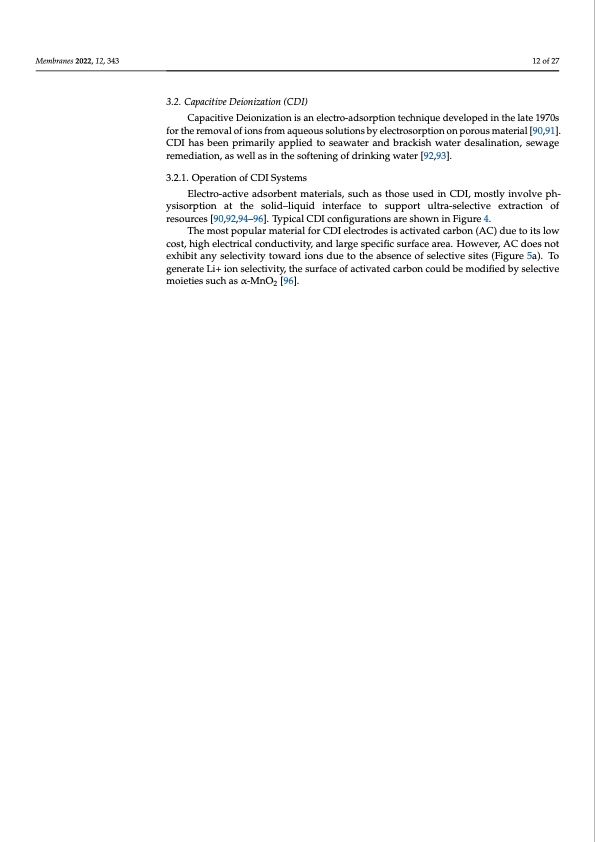
PDF Publication Title:
Text from PDF Page: 012
Membranes 2022, 12, 343 12 of 27 3.2. Capacitive Deionization (CDI) Capacitive Deionization is an electro-adsorption technique developed in the late 1970s for the removal of ions from aqueous solutions by electrosorption on porous material [90,91]. CDI has been primarily applied to seawater and brackish water desalination, sewage remediation, as well as in the softening of drinking water [92,93]. 3.2.1. Operation of CDI Systems Electro-active adsorbent materials, such as those used in CDI, mostly involve ph- ysisorption at the solid–liquid interface to support ultra-selective extraction of resources [90,92,94–96]. Typical CDI configurations are shown in Figure 4. The most popular material for CDI electrodes is activated carbon (AC) due to its low cost, high electrical conductivity, and large specific surface area. However, AC does not exhibit any selectivity toward ions due to the absence of selective sites (Figure 5a). To generate Li+ ion selectivity, the surface of activated carbon could be modified by selective moieties such as α-MnO2 [96].PDF Image | Electro-Driven Materials and Processes for Lithium

PDF Search Title:
Electro-Driven Materials and Processes for LithiumOriginal File Name Searched:
membranes-12-00343-v3.pdfDIY PDF Search: Google It | Yahoo | Bing
Product and Development Focus for Infinity Turbine
ORC Waste Heat Turbine and ORC System Build Plans: All turbine plans are $10,000 each. This allows you to build a system and then consider licensing for production after you have completed and tested a unit.Redox Flow Battery Technology: With the advent of the new USA tax credits for producing and selling batteries ($35/kW) we are focussing on a simple flow battery using shipping containers as the modular electrolyte storage units with tax credits up to $140,000 per system. Our main focus is on the salt battery. This battery can be used for both thermal and electrical storage applications. We call it the Cogeneration Battery or Cogen Battery. One project is converting salt (brine) based water conditioners to simultaneously produce power. In addition, there are many opportunities to extract Lithium from brine (salt lakes, groundwater, and producer water).Salt water or brine are huge sources for lithium. Most of the worlds lithium is acquired from a brine source. It's even in seawater in a low concentration. Brine is also a byproduct of huge powerplants, which can now use that as an electrolyte and a huge flow battery (which allows storage at the source).We welcome any business and equipment inquiries, as well as licensing our turbines for manufacturing.| CONTACT TEL: 608-238-6001 Email: greg@infinityturbine.com | RSS | AMP |